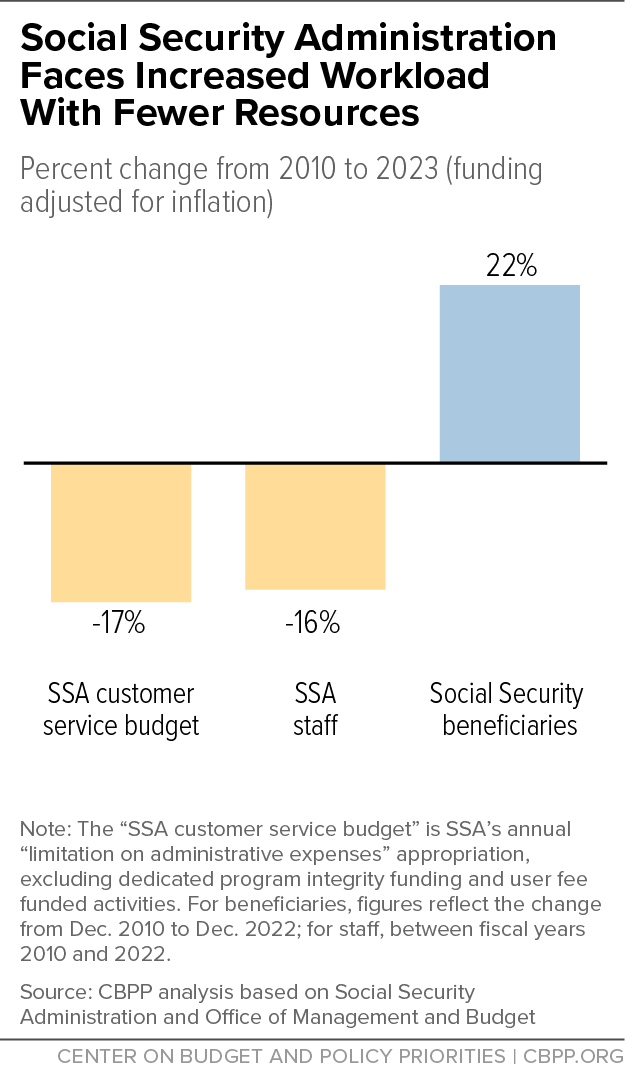BEYOND THE NUMBERS
Social Security Administration Needs Additional Funding to Avoid Exacerbating Customer Service Crisis
The Social Security Administration (SSA) faces a customer service crisis, with applicants for disability benefits and callers on hold at the agency’s toll-free number facing record-long waits. The Biden Administration has proposed some much-needed relief: a $727 million annualized funding increase, to be included in the stopgap funding bill appropriators must pass by September 30 to keep the government open. This is in stark contrast to cuts proposed by House Republicans, which would cut SSA’s operating budget and exacerbate its customer service problems.
Increased funding is necessary to halt SSA's ballooning challenges. SSA has lost thousands of employees due to past hiring freezes and pandemic-era labor force disruptions. If the stopgap bill instead simply freezes SSA’s funding this fall, the agency won’t even be able to replace departing employees, causing further degradation of service. Passing a bill that substantially cuts SSA’s funding, as House Republicans have proposed, would make this problem worse. In addition, call volume and demand for other agency services peaks in the fall, so staff losses would be especially harmful at that time. Congress must act expeditiously to pass a stopgap funding bill with enough additional funding to maintain SSA service as appropriators reach agreements on the rest of the year’s funding.
For over a decade, applicants and beneficiaries for Social Security and Supplemental Security Income (SSI) benefits have suffered from the effects of SSA budget cuts, which have shrunk the agency’s staff and diminished its ability to provide adequate customer service. The cuts are the result of stringent discretionary budget caps imposed in 2011, the last time congressional Republicans provoked a major debt ceiling showdown. Since then, SSA’s customer service budget has fallen by 17 percent, after inflation, with its staffing falling a commensurate 16 percent to a 25-year low. These cuts happened even as the number of Social Security beneficiaries grew by almost 12 million, or 22 percent. (See chart.)
Being forced to serve millions more people with fewer staff and resources has caused tremendous strain at SSA, and beneficiaries are suffering the consequences. Wait times for disability decisions are at a record high, over seven months — often followed by a lengthy appeal. Hold times on the phone have also hit a record in 2023, and are now around 40 minutes, with longer waits at peak times.
If SSA’s full-year funding is insufficient to cover rising costs and growing workloads — or, worse, if its funding is cut again — the agency will be forced to make more painful choices: hiring freezes, furloughs, field office closures, limiting service hours, cutting overtime, or halting IT modernization. Any one of these options would further degrade service, hurting the people who depend on the agency to access their vital benefits.
It doesn't have to be this way. Congress should prevent a government shutdown in October by swiftly passing a bipartisan continuing resolution that temporarily funds the government with adjustments that take care of urgent needs, including more money to ensure Social Security and SSI beneficiaries get adequate service. And then, in acting on regular full-year appropriations, Congress should strongly reject further cuts to SSA’s budget — such as the $250 million cut proposed in the House Republican Labor-Health and Human Services appropriations bill, with potential that cuts could grow steeper — and instead enact the highest funding level possible to help SSA recover from past shortfalls and provide the level of services the public deserves.

